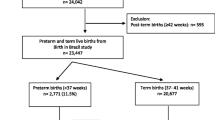Abstract
Objectives: To assess the achievements and effectiveness of efforts to reduce preterm deliveries through the collaborative efforts of funding agencies, scientists, obstetricians, pediatricians, and health care providers in Canada. Methods: Chronological review of studies carried out in Canada within the past two decades using several methodological approaches, including randomized clinical trials, surveys of women and physicians, and prospective cohort studies. Results: Tertiary prevention by treatment of spontaneous preterm labor with beta-agonists was effective in delaying delivery by 48 hr compared with placebo. Ongoing studies tested the comparative efficacy of oxytocin antagonists to beta-adrenergic agents. Recently, nitric oxyde donors have been tested. Secondary prevention using various approaches showed that high-risk factors could not be modified by these interventions. Before applying primary prevention approaches, surveys disclosed the lack of knowledge among both physicians and pregnant women. Conclusion: A recent Canadian consensus meeting emphasized the potential for success by using multidisciplinary, community-based health promotion approaches to prevent preterm labor; enhancing basic research in predictive markers such as cervical change, infection/inflammation, and psychosocial stress; and increasing political involvement of health decision makers.
Similar content being viewed by others
REFERENCES
Papiernik-Berkhauer, E. Coefficient du risque d accouchement prématuré. Presse Med 1969;77:793–94.
Papiernik, E, Keith L, Bouyer J, Dreyfus J, Lazar P. Effective prevention of preterm birth. The French experience measured at Haguenau. Birth defects (original article series). Volume 25,No. 1. White Plains, New York: March of Dimes Birth Defects Foundation, 1989;25(1).
Moutquin, JM. The limits of medical actions: betamimetics. In: Papiernik E, Breart, G, Spira N, editors. Prevention of preterm births: New goals and new practices in prenatal care. Paris: Editions INSERM, 1986;69–81.
Desgranges MF, Moutquin JM, Peloquin A. Effect of maternal long-term therapy or oral salbutamol on the neonatal endocrine status at birth. Obstet Gynecol 1987;69:582–84.
The Canadian Preterm Labor Investigators Group. Treatment of threatened preterm labor with the beta-adrenergic agonist ritodrine. N Engl J Med 1992;327:308–12.
Bessinger RE, Iannveci TA. Tocolytic therapy. In: Preterm labor. Elder, MG, Romero R, Lamont RF. New York: Churchill Livingstone, 1997;243–97.
Moutquin JM, Miner RA, Effer SB, Sinclair JV, Sauve RS. Travail prématuré: utilité de la tocolyse et son impact maternel selon l'âge de la grossesse. Bull Perinatal (Geneve) 1994;18:12–4.
Bernard G, Moutquin JM, Bernard PM, Milner RA, and the Canadian Preterm Investigators Group. A scoring system to predict preterm delivery in women with preterm labor. Society of Obstetricians and Gynecologists of Canada, 52nd Annual Meeting, Quebec City, Canada. June 22–27, 1996; Abstract 014-OBS.
Moutquin JM, Rabinovicci J. Comparison of atosiban versus ritodrine in the treatment of preterm labor. FIGO XV World Congress Meeting, Copenhagen, Denmark, August 4–5, 1997. Acta Obstet Gynecol Scand 1997;76(suppl 16):33.
Moutquin, JM, Milot-Roy V, Irion O. Preterm birth prevention: Effectiveness of current strategies. J Soc Obstet Gynecol Can 1996;18:71–88.
Alexander GR, Weiss J, Hulsey TC, Papiernik E. Preterm birth prevention: An evaluation of programs in the United States. Birth 1991;18:160–9.
Moutquin JM, Bernard, PM, Turcot L, Hache D, Fraser W, Bastide A. Randomized clinical trial of home uterine activity monitoring in high-risk pregnancies. Why is it ineffective. Proceedings of the Society of Obstetricians Gynecologists of Canada, 51st Annual Meeting, Alberta, Canada, June 20–24, 1995.
Dyson, DC, Danbe KH, Bamber JA, Crites YM, Field DR, Maier JA, Newman LA, Ray DA, Walton DL, Armstrong MA. Monitoring women at risk for preterm labor. N Engl J Med 1998;338:15–9.
Berkowitz G, Papiernik E. Epidemiology of preterm birth. Epidemiol Rev 1993;15:414–43.
Armson BA, Dodds L. Prediction of preterm birth in a population of Canadian women. Int J Gynaecol 1994; 46(suppl 1):67
Crane, JMG. Predictors of preterm delivery. Master's thesis, Dalhousie University, Halifax, 1997
Bigirimana PC, Moutquin JM, Bernard PM, Hache D. Risk factors of singleton spontaneous preterm labor: A prospective case control study. Society of Obstetricians Gynecologists of Canada. 52nd Annual Meeting, Quebec City, June 22–27, 1996. Abstract 005-OBS
Preterm Birth Prevention Consensus Conference. Health Canada. Satellite Symposium, Victoria, BC and Hamilton, On, Canada. Society of Obstetricians Gynecologists of Canada and Canadian Pediatric Society Annual Meeting. Summary report available through both societies
Yawn, BA, Yawn, RA. Preterm birth prevention in rural practice. JAMA 1989;262:230–3.
Stewart P, Niday P. An evidence-based community approach to changing practice: The preterm birth prevention program. The Perinatal Newsletter 1997;14:1–2.
Stewart RJ, Nimrod C. The need for a community-wide approach to promote healthy babies and prevent low birthweight. Can Med Assoc J 1993;149(3):281–5.
Moutquin JM. A survey on prematurity prevention in Quebec Province. Proceedings of the 44th Annual Meeting of Obstetricians Gynecologists of Canada, Vancouver, BC, June 22–25, 1988.
Labrecque M, Martin J, Moutquin JM, Marcoux S, Gingras S. Connaissances des femmes enceintes sur la prématurité au Québec. Un Med Can 1993;122:347–52.
Gallagher F, Blanchard P, Cyr R. Prévenir les accouchements prématurés, est-ce possible? Expérimentation d'une stratégie de prévention des accouchements prématurés. Eastern Townships, Direction of Public Health, Bibliothèque Nationale, 1998;ISBN2-921776-08-1
Moutquin JM, Papiernik E. Can we lower the rate of preterm birth? J Soc Obstet Gynecol Can 1990;12:19–21.
Joseph KS, Kramer MS. Recent trends in infant mortality and proportion of low birthweight live births in Canada. Can Med Assoc J 1997;157:535–41.
Morbidity and Mortulity Weekly Report, Preterm singleton birth—United States, 1989–1996. MMWR 1999;48:185–9.
Moutquin JM. A pledge to value pregnant women in Canada. J Soc Obstet Gynecol Can 1998;20:123–6.
Moutquin JM. Preterm birth in Canada. Where do we go from here? J Soc Obstet Gynecol Can 1999;21:115–6.
Author information
Authors and Affiliations
Corresponding author
Rights and permissions
About this article
Cite this article
Moutquin, JM. A Retrospective Assessment of Canadian Preterm Birth Prevention Efforts: 1979–1999. Matern Child Health J 3, 93–97 (1999). https://doi.org/10.1023/A:1021853310631
Issue Date:
DOI: https://doi.org/10.1023/A:1021853310631



